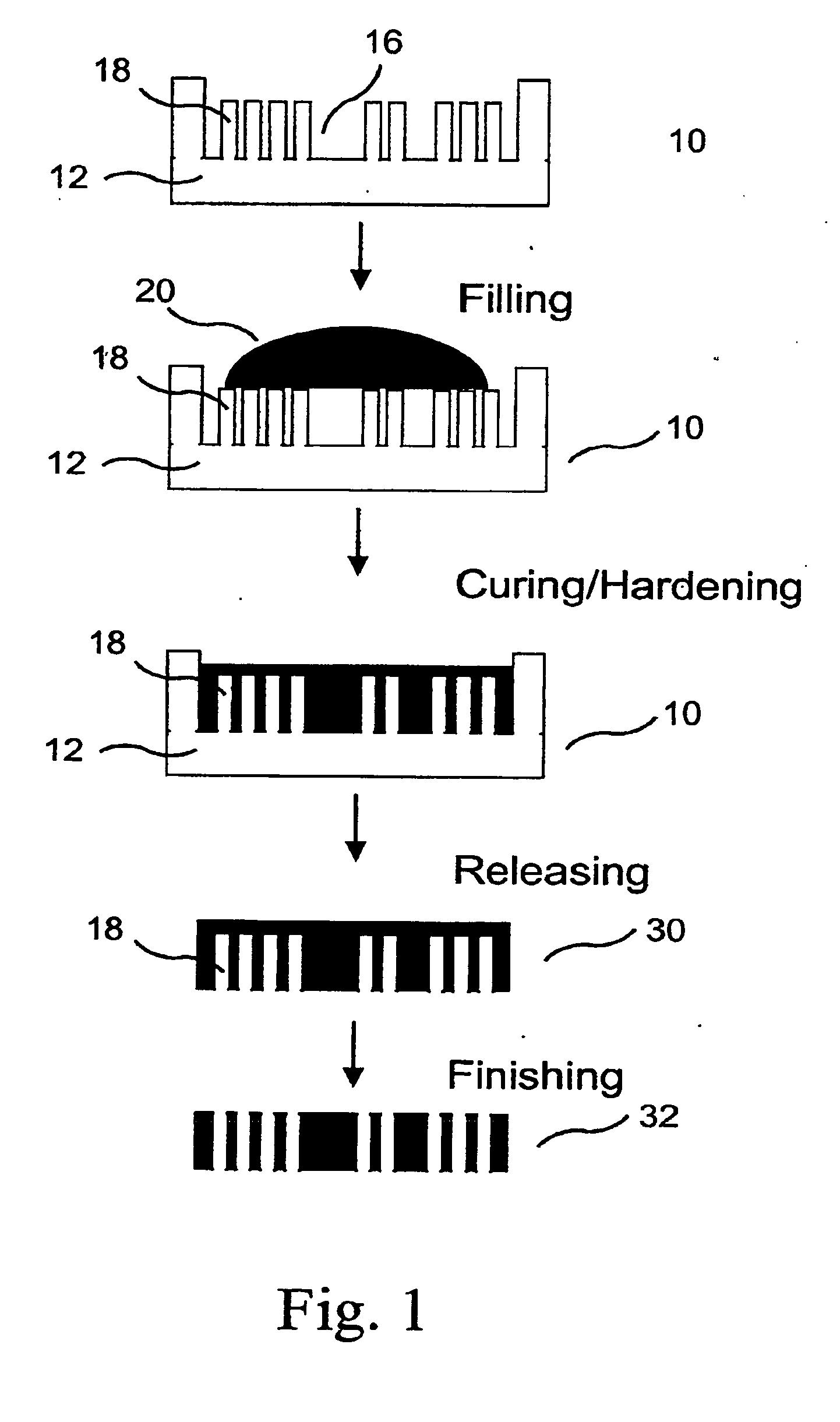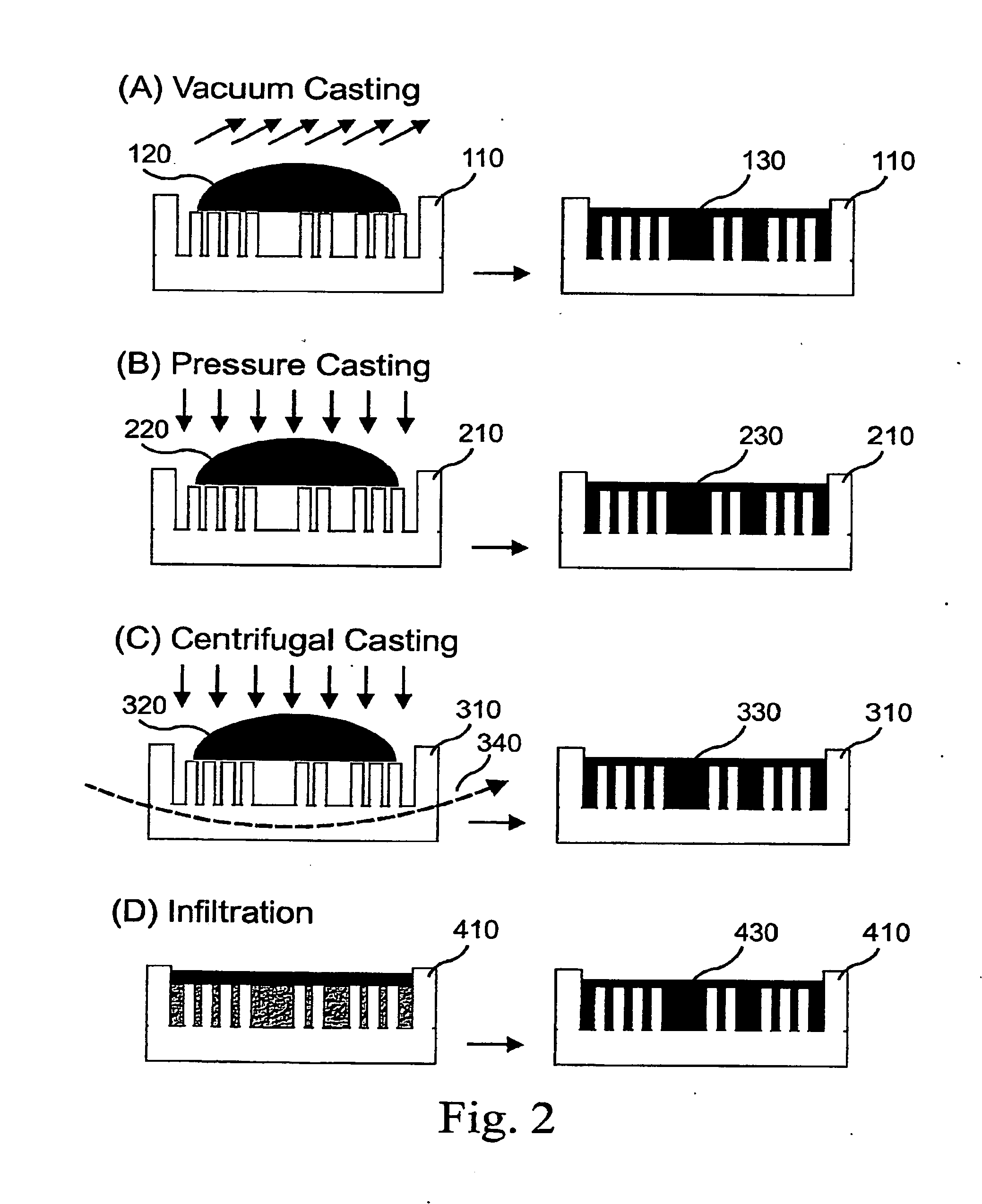High Aspect Ratio Microstructures and Method for Fabricating High Aspect Ratio Microstructures From Powder Composites
a technology of high aspect ratio and microstructure, which is applied in the direction of coating, transportation and packaging, nuclear engineering, etc., can solve the problems of high pressure, inability to use metal powder mixtures, and inability to meet the requirements of injection molding, and achieve high aspect ratio and high precision
- Summary
- Abstract
- Description
- Claims
- Application Information
AI Technical Summary
Benefits of technology
Problems solved by technology
Method used
Image
Examples
example 1
[0054]This exemplary implementation describes fabrication of high aspect ratio tungsten composite grids using epoxy as the binder.
[0055]An SU-8 mold on the graphite substrate was prepared by UV lithography of 600 micron thick SU-8 negative photo resists. The SU-8 mold was patterned with a 64×64 array of square cells, surrounded with a 2 mm border. Each cell has a 341 μm×341 μm square opening separated by 39 μm septa walls. After cleaning, the mold was vapor deposited with a coating of perfluorodecanethiol.
[0056]An RTV silicone rubber mold was prepared by casting Silastic M RTV silicone resin into the prepared SU-8 parent mold. The resin base and its curing agent (ratio of 10:1 by weight) were thoroughly mixed and poured over the SU-8 parent mold, and degassed in a vacuum chamber to remove entrapped air bubbles. After curing of the silicone for 16 hours at room temperature, the elastic RTV mold was peeled from the SU-8 parent mold.
[0057]A molding composition was prepared with 9.2 g W...
example 2
[0058]This exemplary implementation describes fabrication of high aspect ratio tungsten composite collimators with low-melt, fusible metals as the binder using the alternative method as illustrated in FIG. 3.
[0059]A copper lithographic parent mold 510 comprising backing 512 and opening 516 between corresponding elevated patterns 518 was prepared by X-ray lithography. The copper lithographic parent mold is prepared as follows:[0060](a) Positive photoresist, PMMA, is attached on the graphite substrate.[0061](b) The x-ray mask is aligned onto the resist / substrate. This mask / resist / substrate assembly is then exposed at an x-ray source to transfer the pattern to the photo resist. The polymer chains are destroyed in the irradiated portions of the resist, rendering them suitable for solvent removal.[0062](c) The exposed PMMA and substrate is then developed, selectively dissolving the exposed resist while leaving the non-irradiated parts, which remain unchanged.[0063](d) Copper is electropl...
PUM
| Property | Measurement | Unit |
|---|---|---|
| Density | aaaaa | aaaaa |
| Density | aaaaa | aaaaa |
| Density | aaaaa | aaaaa |
Abstract
Description
Claims
Application Information
 Login to View More
Login to View More - R&D
- Intellectual Property
- Life Sciences
- Materials
- Tech Scout
- Unparalleled Data Quality
- Higher Quality Content
- 60% Fewer Hallucinations
Browse by: Latest US Patents, China's latest patents, Technical Efficacy Thesaurus, Application Domain, Technology Topic, Popular Technical Reports.
© 2025 PatSnap. All rights reserved.Legal|Privacy policy|Modern Slavery Act Transparency Statement|Sitemap|About US| Contact US: help@patsnap.com



